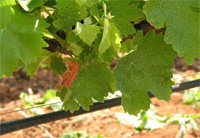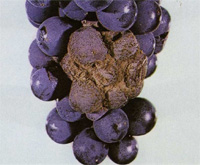Viticultural technical assistance
3 August 2011
The gray mold of the vine
Gray mold (Botrytis cinerea, Pearson Fries) is a fungus that can attack any type of organic substrate, being able to live in a saprophytic and/or parasitic manner depending on environmental and climatic conditions. Botrytis can manifest itself in the vineyard in different forms: scleròtia on shoots, overwintering mycelium on buds and above all, conidia. The production of conidia is concentrated in two moments: at flowering and during maturation. Botrytis can manifest itself with significant damage from the phenological phase of veraison onwards, but with rainy springs, even during pre-flowering and flowering; the fungus attacks the leaves and inflorescences, causing necrosis.
Biology
In order for botrytis to spread, it must develop in a warm-humid environment and there must be open wounds through which it can multiply in the host. To establish the beginning of the primary infection, the "two-fifteen rule" applies, i.e. 15°C of average temperature and 15 hours of watering are necessary, which drops to 4 if the grapes are damaged, to trigger the infection. What matters, therefore, is not so much the intensity of the rain that fell, but the time during which the vegetation remained wet.
Agronomic struggle
Agronomic practices can effectively contain botrytis by modifying the microenvironmental conditions in which mold can develop. Containment of vegetation represents the first intervention capable of reducing botrytis damage to the bunch through:
• irrigation management: the water supply must be supplied to the plant only in certain phenological phases (from fruit set to veraison), with an adequate volume and only to prevent the vine from going into water stress; • nitrogen fertilization: the objective is to obtain a healthy and balanced vineyard. If manure or nitric supplies are excessive, the foliage will develop to the detriment of the bunch, with an increase in the humid microclimate, in the shade in the fruiting strip and in the size and compactness of the grapes; • rootstock: the choice is linked to the type of soil and the possibility of irrigation; if the first is fertile and deep and there are no water limitations, it is advisable to choose a weak rootstock that contains the vegetation and possibly reduces the vegetative cycle of the vine; • varieties: there are very vigorous varieties, regardless of the rootstock and the soil in which they are planted. If these varieties are grafted onto vigorous rootstocks (110 Ri, 1103 P, 140 Ru,) and planted on well-fertilized and irrigated soil, they will produce too many leaves, many bunched shoots and few bunches which will be more susceptible to botrytis;
• pruning and training system: rich pruning, i.e. with the release of many buds, causes bunching of the vegetation, regardless of the training system; the awning induces poor ventilation and double the incidence of botrytis compared to that of the counter-espalier with Guyot or spurred cordon pruning; • management of the foliage: defoliation in the bunch stripe (elimination of the leaves under the bunch, preserving the one opposite the bunch), trimming in the fruiting stripe during fruit setting ONLY where the foliage prevents a good exchange of air or where they can get stuck in the growing bunch, pruning at the right time, thinning of the shoots, are practices that limit the vegetation in the bunch belt, favoring aeration and limiting the humidity which is always a predisposing factor for the onset of botrytis.
Chemical fight
Regardless of the phenological phase of intervention, perfect wetting of the bunches is necessary since in almost all cases these are covering or partially cytotropic products which must totally reach the bunch in order to be effective. The antibotrytic treatment in sensitive and tight bunch varieties (e.g. Chardonnay), in favorable and predisposing conditions (vigour due to unbalanced water and mineral nutrition), must be carried out in the pre-closure phenological phase in order to reduce the inoculum made up of floral residues and to devitalize the conidia. It is essential to intervene before the bunch completely closes because, when the grapes touch each other, the agrochemical is no longer able to penetrate into the pedicel area, where the floral residues can concentrate. Active ingredients such as cyprodinil + fludioxonil or boscalid are recommended in this phase, as they are very effective and have less residue in the wine if used early. Any second treatment, with an active ingredient different from the one used in the first, one month after harvest is recommended only in case of high pathogen pressure, to combat infections. In this case, fenexamide, pyrimethanil, mepanipyrim, complete the defense strategy. The containment of botrytis in organic viticulture can be achieved through the preventive use of microorganisms such as Bacillus subtilis, Trichoderma harzianum and Ulocladium oudemansii which become antagonists of gray mold, from a nutritional and physical bulk point of view, in low pressure conditions of the pathogen. Treatments starting from pre-veraison, based on calcium and magnesium, can help improve the natural resistance of the bunch to the pathogen. The use of copper salts against downy mildew produces a very effective side effect of containment on botrytis.
Ultime notizie
News 9 January 2025
Public Consultation Update PTPCT IRVO 2025-2027
Public consultation for the purpose of updating the Three-Year Plan for the Prevention of Corruption and Transparency (PTPCT) 2025/2027 In order to allow maximum involvement in the preparation of the update of the Three-Year Plan for the Prevention of Corruption and Transparency of the Regional Institute of Wine and Oil for the three-year period 2025/2027, all those who are interested are invited - in particular citizens, companies, consumer associations, representative trade unions, other entities operating in the territory representing particular interests - to send observations and/or proposals to the Person in Charge of the Prevention of Corruption and Transparency (RPCT), which will be evaluated when drafting the document.



